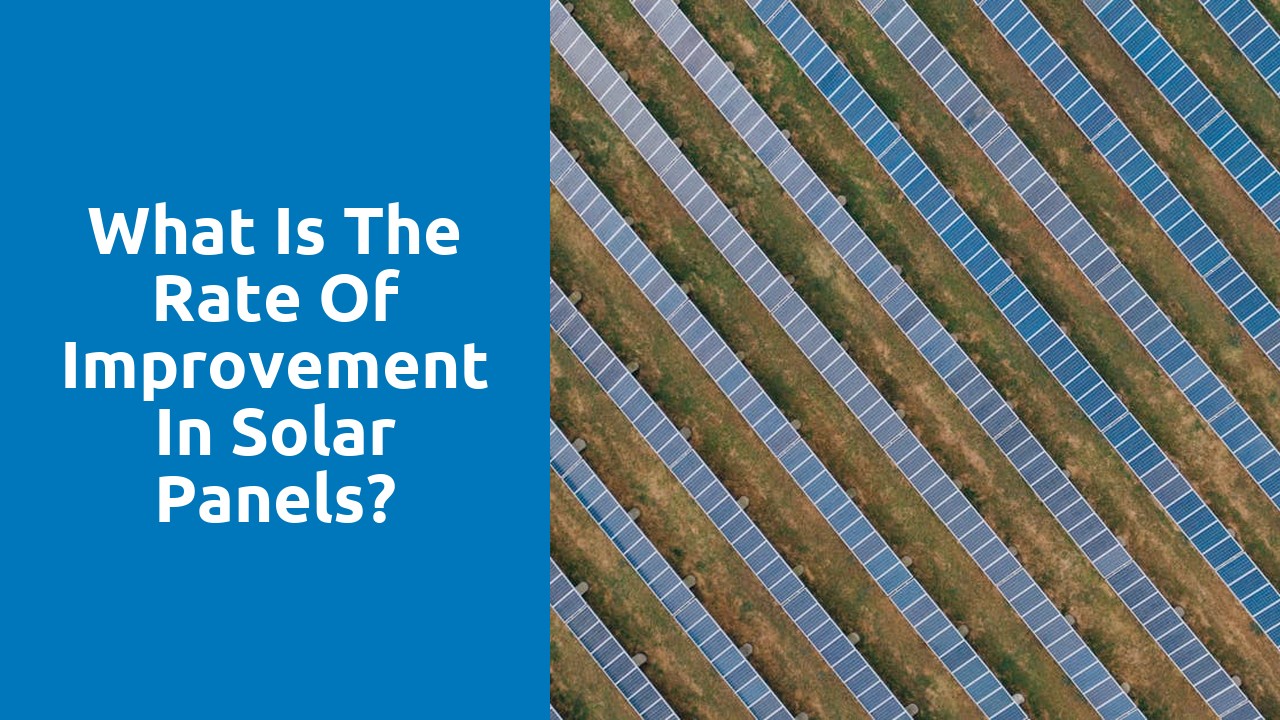
The Evolution of Solar Panel Technology
The evolution of solar panel technology has seen remarkable advancements over the years. One of the key areas of focus has been on increasing the efficiency of solar panels to enhance overall performance. Solar panel manufacturers have been dedicated to improving the efficiency of photovoltaic cells to capture more sunlight and convert it into electricity effectively. This has led to significant Solar Panel System Performance Improvement, making solar energy more accessible and cost-effective for users.
Another notable area of progress in the evolution of solar panel technology is the incorporation of innovative designs and materials. The introduction of thin-film technology has marked a significant milestone in the industry, offering a more flexible and lightweight alternative to traditional solar panels. These advancements in solar panel design have not only improved the aesthetics of solar installations but have also contributed to enhancing efficiency and durability, resulting in a notable boost in Solar Panel System Performance Improvement.
Advancements in Photovoltaic Cells
As solar panel technology continues to advance, photovoltaic cells play a crucial role in enhancing efficiency and performance. Through ongoing research and development, scientists have been able to improve the conversion of sunlight into electricity, leading to significant gains in Solar Panel System Performance Improvement. These advancements in photovoltaic cells have resulted in higher energy outputs and increased durability, making solar panels a more reliable and cost-effective renewable energy solution.
One of the key areas of focus in enhancing photovoltaic cells is the reduction of energy losses during the conversion process. By increasing the efficiency of solar cells, researchers have managed to boost electricity production while minimising waste. These improvements in photovoltaic technology have contributed to the overall enhancement of Solar Panel System Performance Improvement, making solar energy a more viable alternative to traditional fossil fuel-based power sources.
Factors Influencing Solar Panel Efficiency
Solar Panel System Performance Improvement can be influenced by a variety of factors, with sunlight angle and intensity playing a significant role. The angle at which sunlight hits the solar panels can impact how efficiently they convert sunlight into electricity. Panels that are optimally positioned to receive sunlight at a perpendicular angle tend to generate more energy. Moreover, the intensity of sunlight also affects the efficiency of solar panels. Higher intensity sunlight can increase the electricity production of the panels, making them more efficient overall.
Another crucial factor in Solar Panel System Performance Improvement is the design of the panels themselves. Innovations in solar panel design, such as the introduction of thin-film technology, have significantly enhanced the efficiency of solar panels. Thin-film technology allows for the production of lighter and more flexible panels, which can be installed in various locations and orientations to maximize sunlight exposure. These advancements have not only improved the efficiency of solar panels but have also expanded the possibilities for integrating solar energy systems into different environments.
Impact of Sunlight Angle and Intensity
Understanding the impact of sunlight angle and intensity on solar panel system performance improvement is crucial for maximising energy generation. The angle at which sunlight hits the solar panels directly affects the amount of energy absorbed. When sunlight strikes the panels at a perpendicular angle, it is more likely to be absorbed efficiently, leading to increased power output. Adjusting the tilt of solar panels to align with the sun's position throughout the day can significantly enhance their performance and overall energy production.
Moreover, sunlight intensity plays a vital role in determining the output of solar panel systems. Higher intensities of sunlight result in greater energy production due to increased photon energy transfer. Regions with consistent and high levels of sunlight intensity can experience superior solar panel efficiency. Installing solar panels in locations where they receive maximum sunlight exposure can elevate their performance and contribute to sustainable energy generation.
Innovations in Solar Panel Design
In recent years, the field of solar panel design has witnessed remarkable advancements that have significantly contributed to enhancing the efficiency of solar energy systems. One notable innovation that has revolutionized the industry is the introduction of thin-film technology. This advancement involves the use of lighter and more flexible photovoltaic materials, resulting in a more cost-effective and space-efficient solution for harnessing solar energy. The integration of thin-film technology has played a pivotal role in driving Solar Panel System Performance Improvement and making solar energy more accessible to a wider range of applications.
Additionally, the development of bifacial solar panels has emerged as a game-changer in the quest for enhancing solar panel efficiency. These panels have the unique ability to capture sunlight from both the front and back surfaces, increasing energy generation and performance. By maximising sunlight absorption and utilising innovative design features, bifacial solar panels have proven to be instrumental in boosting overall Solar Panel System Performance Improvement, making them a favourable choice for powering residential, commercial, and industrial infrastructures.
Introduction of ThinFilm Technology
Thin-film technology has made significant contributions to the advancement of solar panel systems. This innovative approach involves the deposition of thin layers of photovoltaic material onto a substrate, which allows for flexibility and efficiency in harnessing solar energy. The introduction of thin film has resulted in substantial enhancements to Solar Panel System Performance Improvement, offering a cost-effective solution with lightweight and durable panels that can be integrated into a variety of surfaces.
Moreover, thin-film technology has opened up new possibilities for the integration of solar panels in various settings due to its versatility. By allowing for greater adaptability in design and placement, thin-film solar panels have revolutionised the way solar energy can be utilised across different industries and applications. As a result, the global adoption of this technology has significantly contributed to the ongoing enhancement of Solar Panel System Performance Improvement and the overall efficiency of solar energy production.
FAQS
How fast is the rate of improvement in solar panels?
The rate of improvement in solar panels is constantly evolving, with advancements being made in technology, design, and efficiency every year.
What are some factors influencing the efficiency of solar panels?
Factors such as the angle and intensity of sunlight, the quality of photovoltaic cells, and the design of the panels can all impact the efficiency of solar panels.
How has the introduction of thin-film technology impacted the improvement of solar panels?
The introduction of thin-film technology has revolutionized the design and efficiency of solar panels, making them lighter, more flexible, and easier to install in various settings.
Can advancements in solar panel technology help increase the overall adoption of solar energy?
Yes, advancements in solar panel technology, such as improved efficiency and lower costs, are key drivers in increasing the adoption of solar energy as a sustainable power source.
What are some recent innovations in solar panel design that have contributed to their improvement?
Innovations such as bifacial solar panels, solar tracking systems, and smart inverters have all played a role in enhancing the performance and efficiency of solar panels in recent years.
